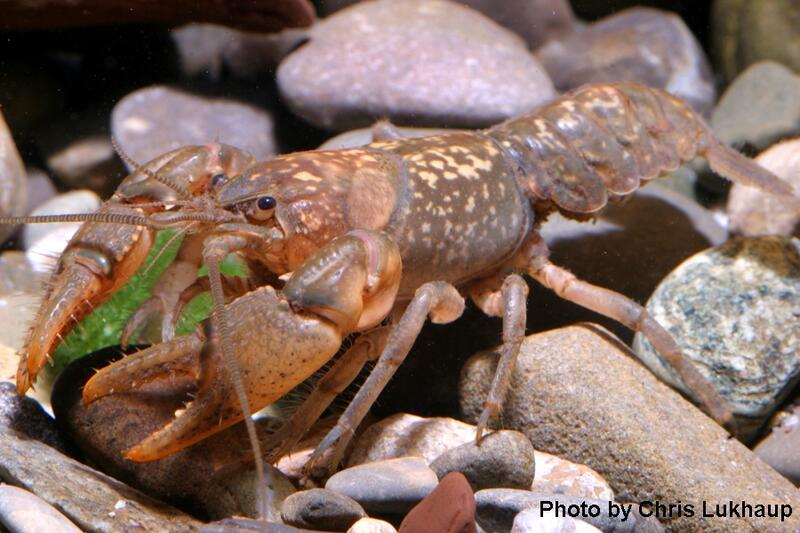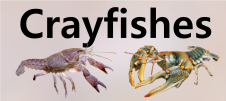







Loading profile. Please wait . . .
Cambarus asperimanus Faxon, 1914
Mitten Crayfish




Federal Protection: No US federal protection
State Protection: No Georgia state protection
Global Rank: G4
State Rank: S2
Element Locations Tracked in Biotics: No
SWAP 2015 Species of Greatest Conservation Need (SGCN): No
SWAP 2025 Species of Greatest Conservation Need (SGCN): No
2025 SGCN Priority Tier: None
Element Occurrences (EOs) in Georgia: 0
Habitat Summary for element in Georgia: Tunnels among gravel and rock in high elevation cascading streams
The overall color of the Mitten Crayfish ranges from brownish-orange to a more olive color with some light mottling. The rostrum is fairly short and squarish and the areola is wide. The claws are rectangular in appearance and the mesial margin of the palm has 5-6 well-developed tubercles. The claws have a “hairy” appearance with abundant setae on the fingers and portions of the palm. This species reaches a maximum total body length of about 60 mm (2.5 in).
The Mitten Crayfish has been collected with Common Crayfish, Cambarus bartonii. Both species have a single row of tubercles on the mesial margin of the palm, but those of C. bartonii are typically flattened and inconspicuous. Common Crayfish do not have “hairy” claws and their overall color is typically olive-brown with dark mottling rather than having orangish tones.
The Mitten Crayfish is usually found at higher elevations in very small streams (<1 m) to streams 4-5-m wide. They tunnel among rocks in flowing areas of larger streams and among rocks and woody debris in small streams.
No studies of the Mitten Crayfish are known. Crayfishes are considered opportunistic omnivores and likely feed on live and decaying vegetation, aquatic insects, small fishes, and dead animal matter.
Stream dwelling crayfishes typically hide during the day and come out at night to feed. Reproduction usually occurs during the spring and fall, but males in reproductive condition may be found at any time during the year. When female crayfish are ready to lay eggs, they usually find a secure hiding place and hence are rarely encountered. When the eggs are released, the female attaches them to her swimmerets and is said to be "in berry." Upon hatching, the juvenile crayfish are attached to the mother by a thread. After the juveniles molt for the second time, they are free of the mother, but stay close and will hold on to her for some time. Eventually they move off on their own. Crayfishes molt 6 or 7 times during their first year of life and most are probably able to reproduce by the end of that year. They molt once or twice a year for the remainder of their lives and live about 3 years. A single male in reproductive condition was collected in June and a female carrying eggs was collected on 26 April 1977. Across its range, first form males have been found from May to October (Hobbs 1981). The only reproductive male known from Georgia is about 55 mm (2.2 in) and the single female with eggs about 61 mm (2.4 in) in length (Hobbs 1981).
This species can be difficult to find; it is typically not found beneath a single rock on the surface of the stream bed like many species. Since this species essentially tunnels among rocks, a surveyor must patiently remove rocks one at a time in the proper habitat and catch the crayfish by hand or guide it into a dipnet.
In Georgia the Mitten Crayfish is found in the Blue Ridge and upper Piedmont physiographic provinces in the headwaters of the Savannah and Little Tennessee river systems. Elsewhere it is known from the upper Broad, Saluda, and Savannah systems in South Carolina, the headwaters of the Broad, Catawba, French Broad, Little Tennessee, and Yadkin Pee-Dee rivers in North Carolina, and the Watauga River system in eastern Tennessee (Eversole and Jones 2004; Hobbs 1981, 1989; Simmons and Fraley 2010).
Heavy sedimentation resulting from poor development and land management practices may cover substrates and other daytime hiding places on which crayfishes rely to avoid predation. The introduction of non-native crayfishes is a threat to all native crayfishes.
Despite the narrow range of this species, it is thought to be stable in Georgia at this time. At least some of its Georgia range is on US Forest Service property which is somewhat protected.
Conserving populations of the Mitten Crayfish will require general watershed level protection measures, including the protection of riparian zones, control of sediment and nutrient runoff from farms and construction sites, and limiting the amount of impervious cover (e.g., pavement) within occupied watersheds. Non-native crayfishes should never be used for bait. Instead, anglers should use crayfishes collected from the river system they will be fishing in and should never release unused bait crayfish back into Georgia waters.
Eversole, A.G. and D.R. Jones. 2004. Key to the Crayfish of South Carolina. US Forest Service Publication. 79 pp.
Hobbs, H.H., Jr. 1981. The crayfishes of Georgia. Smithsonian Contributions to Zoology 318:1–549.
Hobbs, H.H., Jr. 1989. An illustrated checklist of the American crayfishes (Decapoda: Astacidae, Cambaridae, and Parastacidae). Smithsonian Contributions to Zoology 480:1–236.
Simmons, J.W. and S.J. Fraley. 2010. Distribution, status, and life-history observations of crayfishes in western North Carolina. Southeastern Naturalist 9 (Special Issue 3):79–126.
Taylor, C.A., G.A. Schuster, J.E. Cooper, R.J. DiStefano, A.G. Eversole, P. Hamr, H.H. Hobbs III, H.W. Robison, C.E. Skelton, and R.F. Thoma. 2007. A reassessment of the conservation status of crayfishes of the United States and Canada after 10+ years of increased awareness. Fisheries 32:372–389.
Christopher E. Skelton
C. Skelton, 2012: original account
C. Skelton, February 2019: general update of account.